|
Real-Time Eye Gaze Tracking Under Natural Head Movements
|
|
|
|
|
|
|
|
Eye gaze
is defined as the line of sight of a person. It represents a person's focus
of attention. Eye gaze tracking has been an active research topic for many
decades because of its potential usages in various applications such as
Human Computer Interaction (HCI), Virtual Reality, Eye Disease Diagnosis
and Human Behavior Study, etc.
|
|
|
|
|
|
|
|
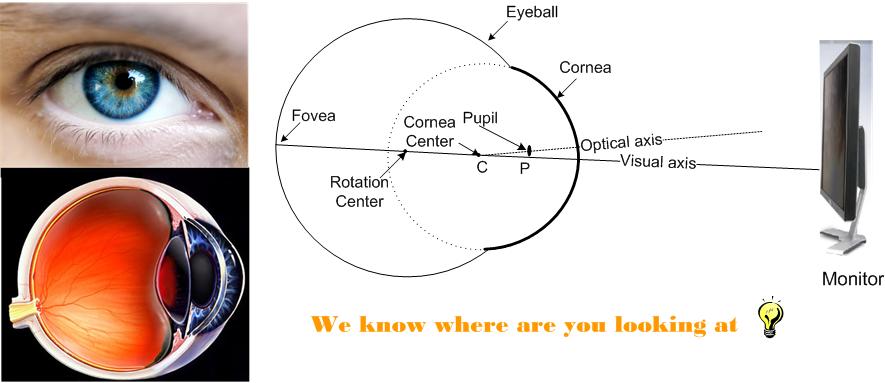
|
|
|
|
|
|
|
Unlike
most of the existing gaze tracking techniques, which often require a static
head to work well and require a cumbersome calibration process for each person,
our gaze tracker can perform robust and accurate gaze estimation under
natural head movements with only one-time calibration. We
have developed three different gaze tracking systems based on different
configurations:
Our proposed methods will dramatically increase the
usability of the eye gaze tracking technology, and we believe that it is a
big step for the eye tracker to be accepted as a natural computer input
devices.
|
|
|
|
|
|
|
Stereo-Camera Eye Gaze Tracker
|
|
|
In
this system, the 3D eye position can be obtained by a pair of stereo
cameras. Then, we have two algorithms to accommodate the eye position changes
: (A) Based on the obtained eyeball position, the gaze mapping function at
the new position can be automatically updated by the proposed dynamic
computational head compensation model to accommodate the eye position
changes. (B) By the proposed 3D gaze tracking, we can directly estimate the
3D virtual axis without any mapping functions. Both of the two proposed
method can achieve the accracy less than 1 degree.
|
|
|
|
|
|
|
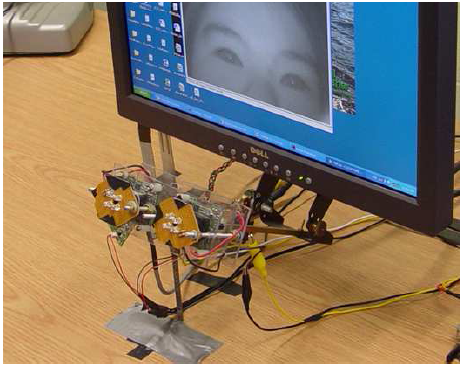
|
|
|
Fig.1
Configuration of stereo camera system
|
|
|
|
|
|
|
Publications:
|
|
|
(1)
Jixu Chen, Yan Tong, Wayne Gray, Qiang Ji, “A robust 3D eye gaze tracking system using noise reduction,“ presented in symposium on Eye tracking
research & applications (ETRA), March 2008.
(2) Zhiwei Zhu and Qiang Ji, " Novel Eye Gaze
Tracking Techniques Under Natural Head Movement," to appear in
IEEE Transactions on Biomedical Engineering.
(3) Zhiwei Zhu, Qiang Ji, "Eye Gaze Tracking Under Natural Head
Movements." International Conference on Computer Vision and
Pattern Recognition (CVPR05), San Diego, CA, June 2005.
(4) Zhiwei Zhu, Qiang Ji, "Eye Gaze Tracking Under Natural Head
Movements." International Conference on Computer Vision and
Pattern Recognition (CVPR05), San Diego, CA, June 2005.
(5) Zhiwei Zhu, Qiang
Ji, "Eye and Gaze Tracking for Interactive
Graphic Display." Machine Vision and Applications, Pages
139-148, Vol.15, No.3, July 2004.
(6) Qiang Ji, Zhiwei
Zhu, "Eye and Gaze Tracking for Interactive
Graphic Display." 2nd International Symposium on Smart
Graphics, Hawthorne, NY, USA, June 11-13, 2002.
|
|
|
|
|
|
|
Demos:
|
|
|
|
|
|
|
|
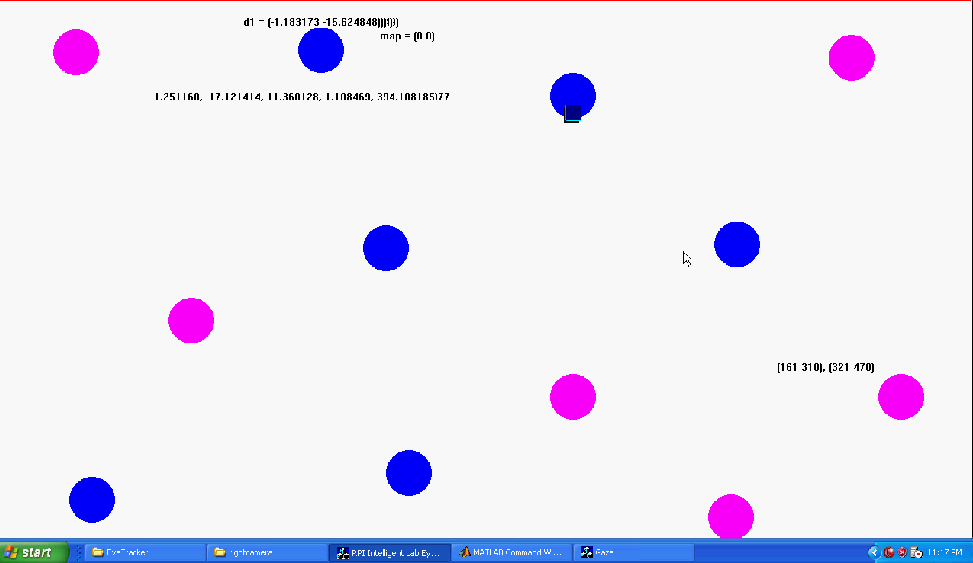
|
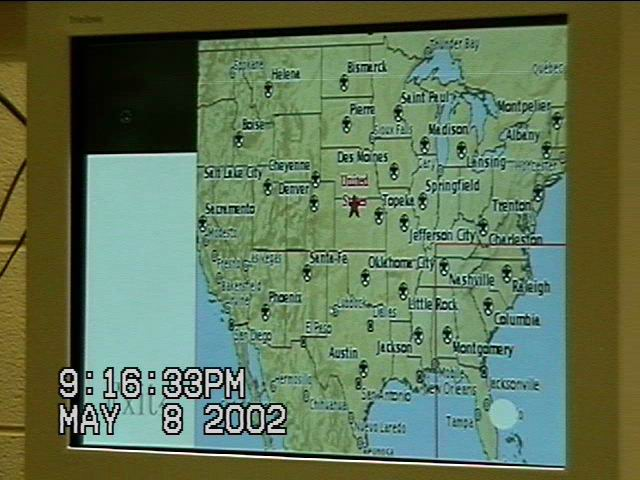
|

|
|
|
Eye gaze tracking demo
|
Map control via eye gaze
|
Word reading via eye gaze
|
|
|
|
|
|
|
|
Note: in the first demo, the static cirles with different colors
represent the reference objects that the user will look at. The blinking
square that changes locations is the estimated gaze point, representing
where the user is looking at.
|
|
|
|
|
|
|
|
back
|
|
|
|
|
|
|
Multi-Camera Eye Gaze Tracker
|
|
|
This
system is based on one-camera gaze estimation algorithm. By this algorithm,
the 3D eyeball position can be estimated by the two corneal reflections
(glints) of the IR lights. In our multi-camera gaze tracker, each camera
can estimate the gaze independently, So it allows very large head movement.
The accuracy of this system is also less than 1 degree.
|
|
|
|
|
|
|
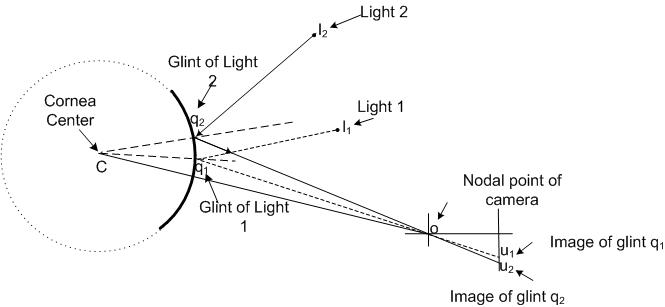
|
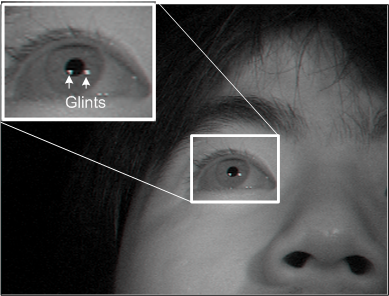
|
|
|
Fig.2 One-camera gaze
estimation algorithm
|
Fig.3 Captured image by one
camera
|
|
|
|
|
|
|
|
|
|
Fig.4 Configuration of one
camera system
|
Fig.5
Configuration of two camera system. (Note: each of the two camera can track
the eye independently. So the allowed head movement is very large)
|
|
|
|
|
|
Demos:
|
|
|
|
|
|
One camera gaze tracking demo
(Note:
The head can move freely in the view of the camera)
|
|
Two camera gaze tracking demo
(Note:
The gaze point can be estimated, even when only one camera can capture the
eye. So it allows larger head movement)
|
|
|
back
|
|
|
|
|
|
|
|
Eye Gaze Tracking With a Monocular Camera
and a Steering Mirror
|
|
|
We
propose an eye gaze tracking system under natural head movements. The
system consists of one CCD camera and two mirrors. Based on geometric and linear
algebra calculations, the mirrors rotate to follow head movements in order
to keep the eyes within the view of the camera. Our system allows the
subjects head to move 30 cm horizontally and 20 cm vertically, with spatial
gaze resolutions about 6 degree and 7 degree, respectively and a frame rate
about 10 Hz. We also introduce a hierarchical generalized regression neural
networks (H-GRNN) scheme to map eye and mirror parameters to gaze,
achieving a gaze estimation accuracy of 92% under head movements. The use
of H-GRNN also eliminates the need for personal calibration for new
subjects since H-GRNN can generalize. Preliminary experiments show our
system is accurate and robust in gaze tracking under large head movements.
For details, see the following publication.
|
|
|
|
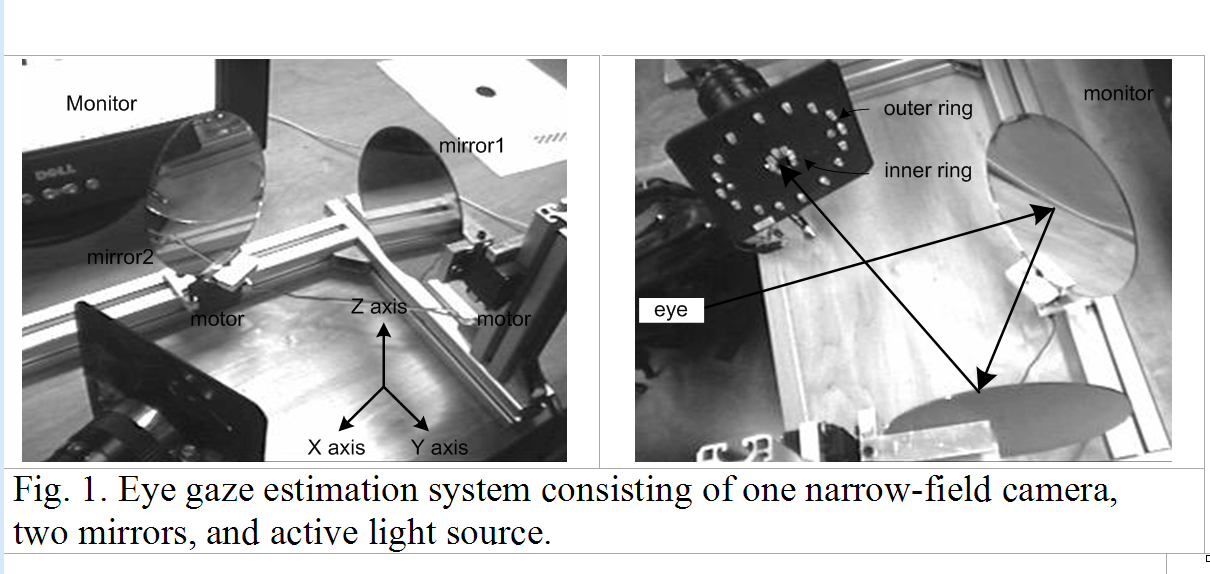
|
|
|
|
|
|
|
Publications:
|
|
|
(1) Soochan Kim and Q. Ji, Non-intrusive Eye Gaze Tracking
Under Natural Head Movements, 26th Annual International Conference IEEE
Engineering in Medicine and Biology, Sep., 2004
|
|
|
|
|
|
|
|
back
|
|
|
|
|
|
|
|
|
|
|
|
|
|
|
|
|
|
|